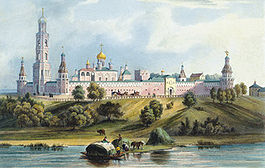
Simonov Monastery
Encyclopedia

Moscow
Moscow is the capital, the most populous city, and the most populous federal subject of Russia. The city is a major political, economic, cultural, scientific, religious, financial, educational, and transportation centre of Russia and the continent...
was established in 1370 by monk Feodor, a nephew and disciple of St Sergius of Radonezh
Sergius of Radonezh
Venerable Sergius of Radonezh , also transliterated as Sergey Radonezhsky or Serge of Radonezh, was a spiritual leader and monastic reformer of medieval Russia. Together with Venerable Seraphim of Sarov, he is one of the Russian Orthodox Church's most highly venerated saints.-Early life:The date of...
.
The monastery
Monastery
Monastery denotes the building, or complex of buildings, that houses a room reserved for prayer as well as the domestic quarters and workplace of monastics, whether monks or nuns, and whether living in community or alone .Monasteries may vary greatly in size – a small dwelling accommodating only...
land formerly belonged to Simeon Khovrin, a boyar
Boyar
A boyar, or bolyar , was a member of the highest rank of the feudal Moscovian, Kievan Rus'ian, Bulgarian, Wallachian, and Moldavian aristocracies, second only to the ruling princes , from the 10th century through the 17th century....
of Greek extraction
Principality of Theodoro
The Principality of Theodoro , also known as Gothia , was a small principality in the south-west of Crimea from the 13th through 15th centuries. Its capital was Doros, which was also sometimes called Theodoro and is now known as Mangup...
and progenitor of the great clan of Golovin
Golovin
Golovin may refer to:*Golovin , people with the surname Golovin or Golovina*Golovin, Alaska, a US city-See also:*Maria Golovin, an opera by Gian Carlo Menotti...
s. He took monastic vows in the cloister under the name Simon (hence the name); many of his descendants are also buried there. In 1379, the monastery was moved half a mile to the east. Its original location, where bodies of the warriors killed in the Battle of Kulikovo
Battle of Kulikovo
The Battle of Kulikovo was a battle between Tatar Mamai and Muscovy Dmitriy and portrayed by Russian historiography as a stand-off between Russians and the Golden Horde. However, the political situation at the time was much more complicated and concerned the politics of the Northeastern Rus'...
had been buried, is still commemorated by the old Simonov church.
During the 15th century, the cloister was the richest in Moscow. Among the learned monks who lived and worked there were Vassian Patrikeyev
Vassian Patrikeyev
Vassian Patrikeyev, also known as Vassian Kosoy was a Russian ecclesiastic and political figure and writer...
and Maximus the Greek
Maximus the Greek
Maximus the Greek, also known as Maximos the Greek or Maksim Grek , was a Greek monk, publicist, writer, scholar, humanist, and translator active in Russia...
. A white stone cathedral was erected in 1405; it was later enlarged by order of Ivan the Terrible. As the monastery defended southern approaches to Moscow, it was heavily fortified in the 1640s. The last addition to the complex was a huge multi-storied bell-tower, modelled after Ivan the Great Bell Tower
Ivan the Great Bell Tower
The Ivan the Great Bell Tower is the tallest of the towers in the Moscow Kremlin complex, with a total height of . It was built in 1508 for the Russian Orthodox cathedrals in Cathedral Square, namely the Assumption, Archangel and Annunciation cathedrals, which do not have their own belfries...
of Moscow Kremlin
Moscow Kremlin
The Moscow Kremlin , sometimes referred to as simply The Kremlin, is a historic fortified complex at the heart of Moscow, overlooking the Moskva River , Saint Basil's Cathedral and Red Square and the Alexander Garden...
.
The monastery was abolished by the Bolsheviks in 1923, and soon thereafter most of its buildings were demolished to make way for an automobile plant. Surviving structures all date back to the 17th century and include three tower
Tower
A tower is a tall structure, usually taller than it is wide, often by a significant margin. Towers are distinguished from masts by their lack of guy-wires....
s of cannon-like appearance and auxiliary buildings in the Naryshkin baroque
Naryshkin Baroque
Naryshkin Baroque, also called Moscow Baroque, or Muscovite Baroque, is the name given to a particular style of Baroque architecture and decoration which was fashionable in Moscow from the turn of the 17th into the early 18th centuries.-Style:...
style. Recently the Moscow government announced plans for a full-scale reconstruction of the famous cloister.
According to several sources, part of the former monastery buildings was transferred in 1990 from the Ministry of Culture of the USSR to Russian Orthodox Church
Russian Orthodox Church
The Russian Orthodox Church or, alternatively, the Moscow Patriarchate The ROC is often said to be the largest of the Eastern Orthodox churches in the world; including all the autocephalous churches under its umbrella, its adherents number over 150 million worldwide—about half of the 300 million...
and Orthodox community of deaf people, who began the works on restoration and reconstruction of its facilities. The first service here after the restoration was held in 1992.
 |
||||
| Osip Startsev's refectory | The earliest photograph of the monastery dates from 1882. | The distinctive appearance of the monastery towers is without a parallel anywhere in Russia. |

